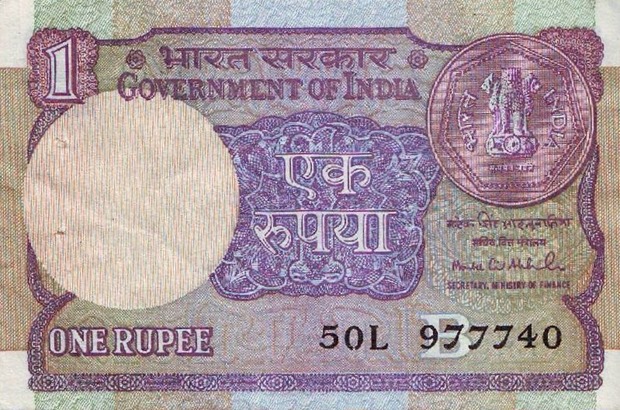Rupee 1 Currency Note To Be Reintroduced After 20 Years

Reserve Bank of India has decided to reintroduce Rupee One currency note after a gap of 20 years. The last Re 1 currency note was printed in 1994, but after that, they were replaced by coins and owning to higher costs of maintenance and replacement, the printing was stopped.
However, what encouraged and motivated RBI to reprint Re 1 note in 2015 is still not clear.
The dimensions of the note would be 9.1 X 6.3 cms, and would be rectangular in shape. It would be 110 microns thick and weigh 90 GSM (Grams per Square Meter); and the material would be 100% cotton content rag.
For watermarks, Hindi numeral ‘1’ would be placed in the center, and Ashoka Pillar would be seen in the window. However, the term ‘‘???????? ????’ (Satyamev Jayate) would not be used. ‘????’ (Bharat) would be placed vertically, in a hidden mode, which would only be visible once the currency note is viewed against light.
Contents
Front Side:
The words “???? ?????” (Bharat Sarkar) would be placed above the words “Government of India”. Bilingual signature of Mr. Rajiv Mehrishi who is the Finance Secretary would be placed along with the image of a Re 1 coin. Year 2015, along with ‘???????? ????’ (Satyamev Jayate) and capital insert letter ‘L’ in numbering panel would be placed strategically. The numbering will be in black at right hand bottom portion of the note.
Reverse Side:
Along with the terms “???? ?????” (Bharat Sarkar) and Government of India, along with year 2015 and an image of Re 1 coin, the reverse side will also have the image of Sagar Samrat (oil exploration in sea) and the translation of Re 1 in 15 official Indian languages.
Overall, the currency note would be using a color combination of pink and green.
Brief History of Re 1 Note
The first Re 1 note was issued as on November 30th, 1917 which featured the image of King George V with signatories of M. M. S. Gubbay, A. C. Mc Watters & H. Denning. These were printed on white hand-made moulded paper and were packed in group of unstapled 25 notes.
Re 1 was valued as $13 during 1917; whereas 1 dollar is now valued at Rs 62.
After independence in 1947, the image of King George V was replaced with Emperor Asoka; however, initially it planned tom use Mahatma Gandhi’s image, which was later adapted for all other currencies except Re 1.
Here is the official history of Re 1 note, as published by RBI.
3 Interesting Facts about Re 1
- All currency notes are printed by RBI but Re 1 note was always printed by Government of India
- Re 1 note doesn’t have the statement: “I promise to pay the bearer a sum of XXX rupees..” which normally exists in currency of other denominations.
- All other currency notes bear the signature of RBI Governor, but Re 1 note has the signature of Finance Secretary as its printed by RBI.
Old Re 1 currency notes are eagerly sought by collectors, and some of them are being sold between Rs 1000 to Rs 13,000 on Ebay.
Here is the official notification by RBI regarding Re 1 recirculation.

Nice article.
Interesting history. Interesting to note the owner of 1 rupee and other currencies (Govt of India and RBI).
But I was surprised to see that the raw material is 100% cotton rags. Though it is good to recycle cotton, I would have recommended plastic as raw material.
The Logic is : What is the reason for discontinuing 1 rupee note? The cost far exceeds the value. In the last article on plastic currency, it was widely appreciated that plastic currency will last several times more years than paper currency. This fact itself will reduce the cost of circulating money in the system by many times. So why not use plastic for one rupee. Once circulated, it will be the most used paper in rural India compared to 5, 10s. So the logic is why not sue plastic for the most used paper currency?
Another argument for answering the Author’s question of why 1 rupee is reintroduced after 20 years.
May be rupee will appreciate in value as India becomes stronger. This is the reverse of rupee becoming weaker against dollar. As rupee weakened continuously over the decades, we discontinued 1 paisa, 2 paisa, 3 paisa, 5 paisa, 10 paisa and so on in coins and 1 rupee in paper. Now with India becoming stronger, may be govt is sensing to reintroduce the discarded currencies. I wish to see 1 paisa once again in circulation in my life time :)
Just my two paisa :)